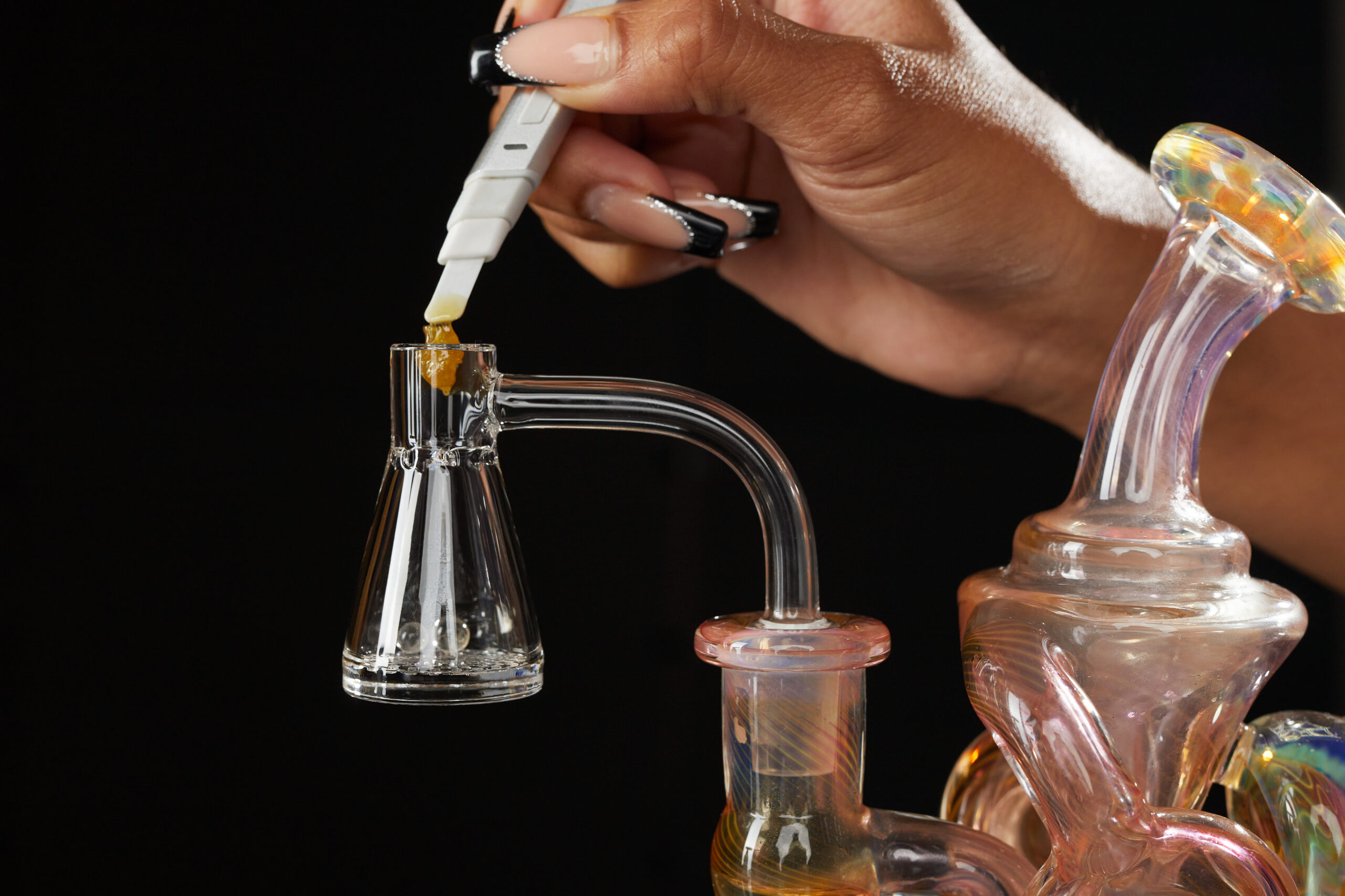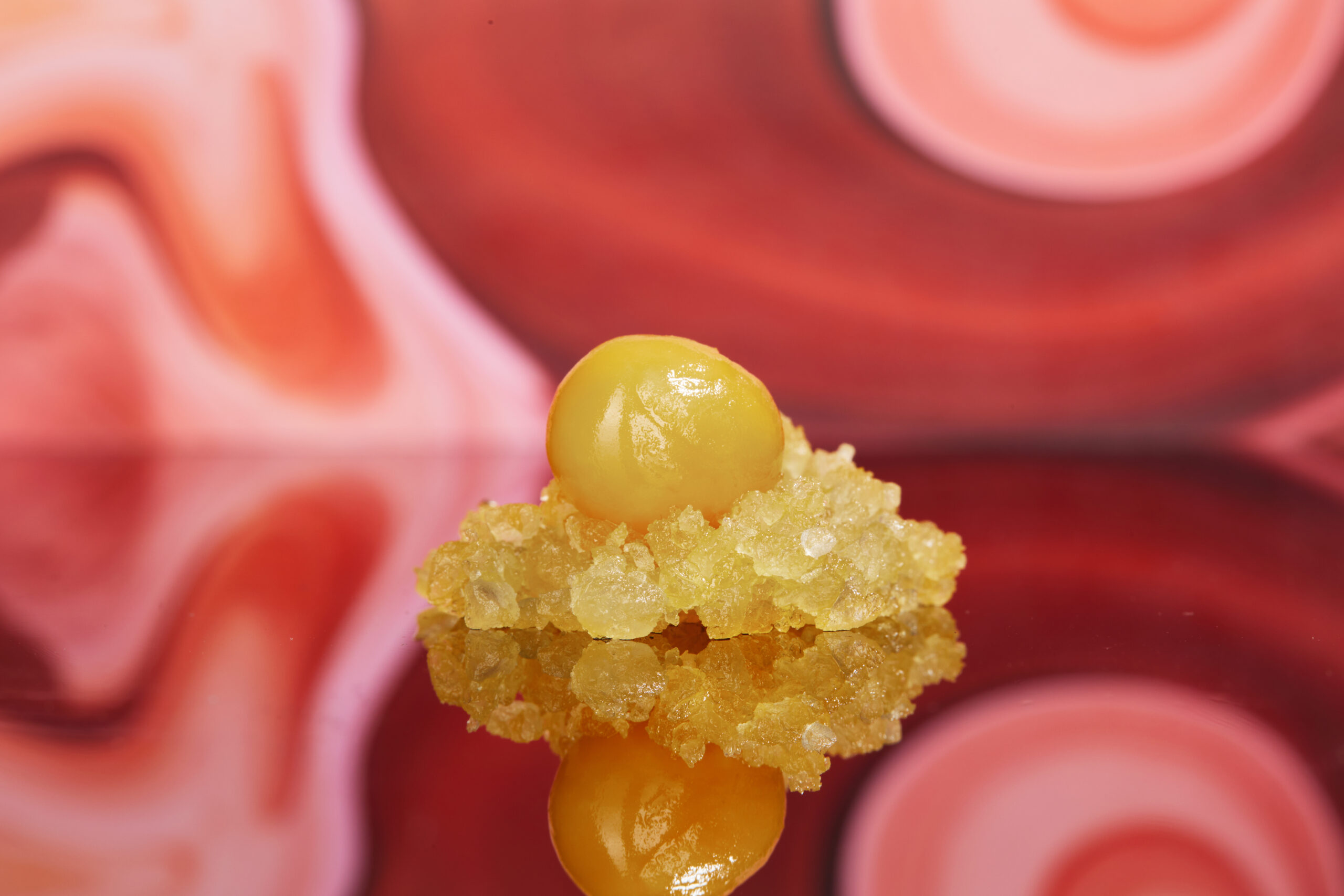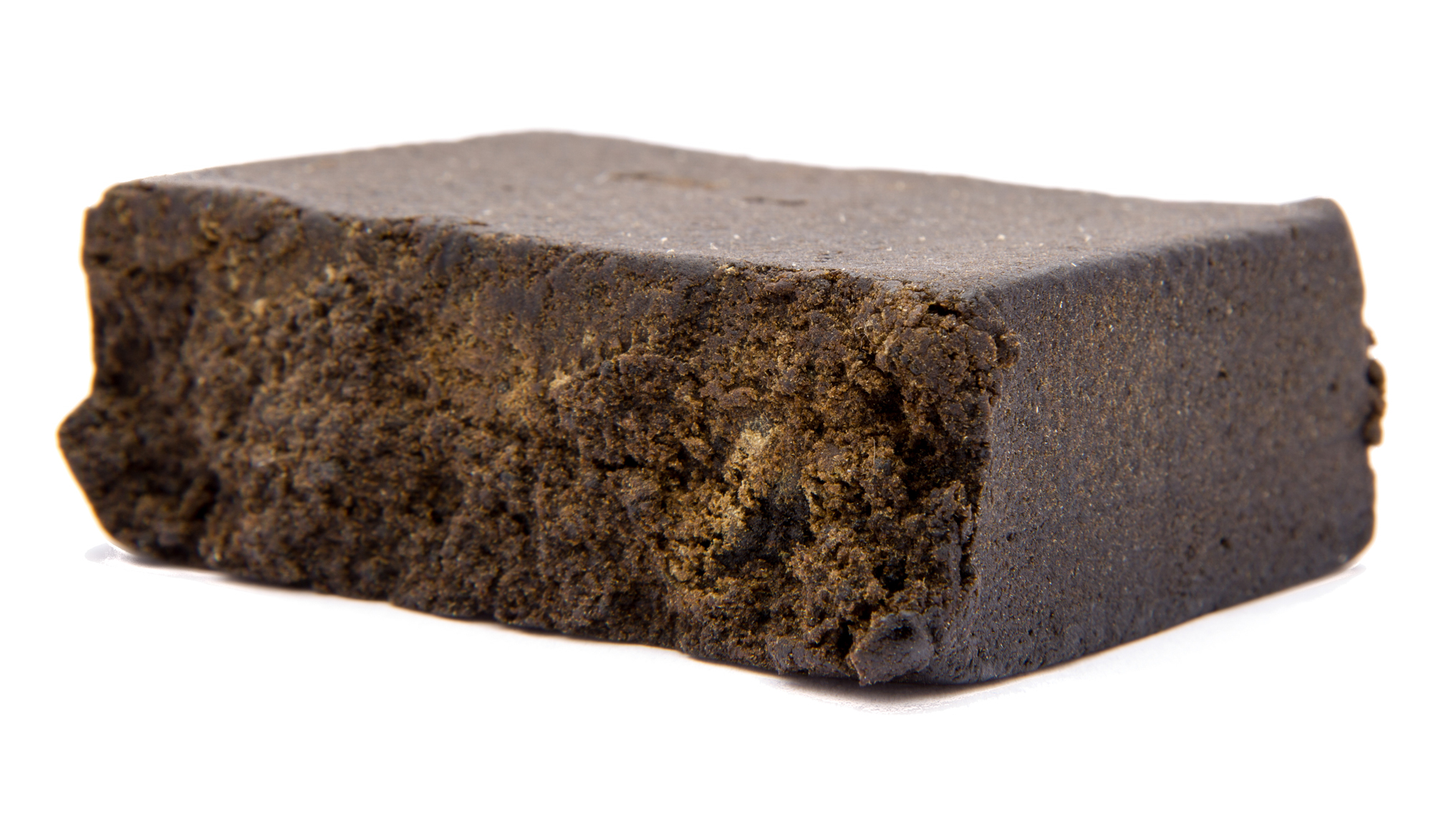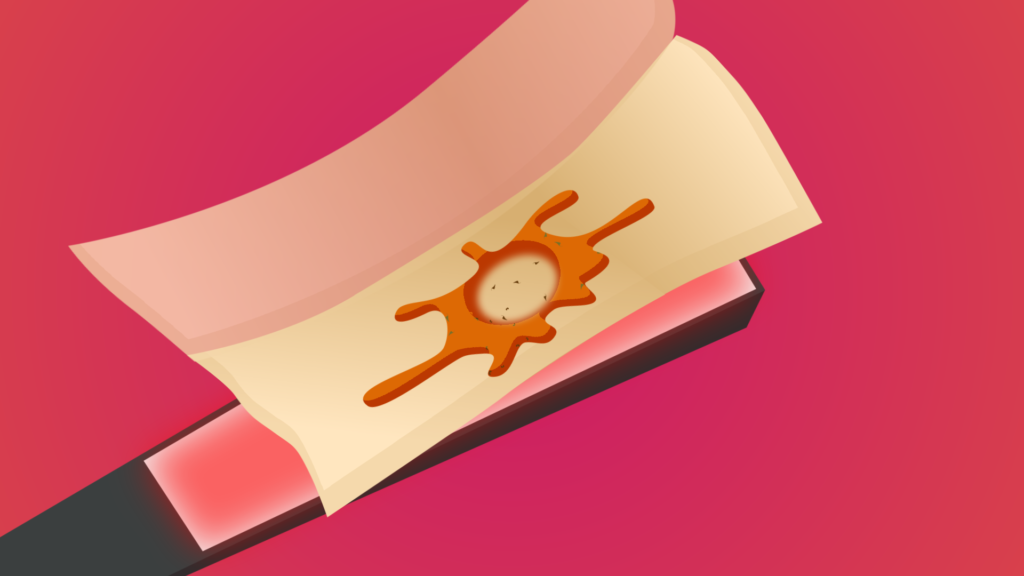Before terp slurpers, electronic vaporizers, and even hot knives, dabbing has been an integral part of cannabis culture. Today, it has become one of the most popular ways to consume cannabis. And as technology advances both the methods of consumption and types of concentrates available to dab, its expansive history remains.
What is dabbing?
Dabbing is the act of inhaling vaporized cannabis concentrates via a device such as a dab rig, dab pen, e-rig, or vaporizer. It's popular for both recreational and medicinal consumers due to the lack of combustion needed to inhale it, along with its bioavailability and richness in terpenes.
Types of concentrates you can dab
Since dabbing involves consuming concentrated forms of cannabis, the high you get from dabbing is typically stronger than the one you get from smoking flower.
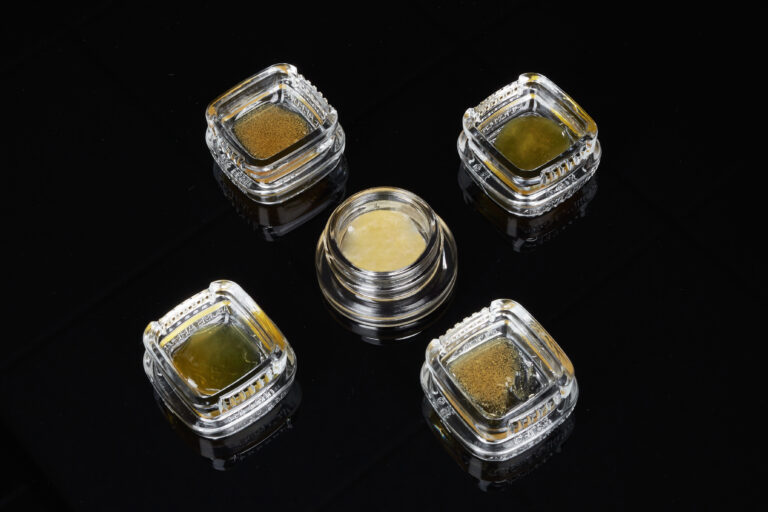 Photo by: Gina Coleman/Weedmaps
Photo by: Gina Coleman/WeedmapsImage lightbox

Dabbers have an array of choices when it comes to the type of concentrate they can dab, with various consistencies.
Kief and hash
Kief is the loose cannabis trichomes collected after grinding fresh cannabis — it comes in a powdery green form. Hash is kief that's been pressed and usually formed into a brick, though other consistencies are available:
- Temple ball: Hash that is cured and pressed into a ball. Temple balls are typically used to top bowls of flower or are rolled into joints.
- Sand: Hash that is sifted and can be sprinkled on top of flower or pressed for dabbing.
Rosin
Made by applying heat and pressure to cannabis flower or bud, rosin can be made easily at home or found in almost any dispensary. Consistencies of rosin include:
- Fresh press: Maintains a sap-like consistency that can be dabbed.
- Cold cure: Rosin that's left to cure at low temperatures. It's whipped after, resulting in a smooth and creamy consistency.
- Jam/Sauce: Rosin that has a viscous and syrupy texture, similar to the consistency of jam or sauce.
- Solventless diamonds: Rosin in a crystalline structure that resembles diamonds. It's produced without the use of solvents, resulting in a clean and pure extract.
Live resin
Live resin is produced using a solvent and fresh flower. This method of extraction maintains the starting cannabis terpenes, which makes for an incredibly flavorful experience.
- Shatter: A brittle form of resin with a glass-like texture, obtained through solvent extraction and careful cooling.
- Sap: Sticky and viscous concentrate resembling tree sap, offering a liquid-like consistency and flavorful experience.
- Crumble: Dry and honeycomb-like resin created through solvent extraction.
- Badder/Budder: Soft and creamy form or resin, similar to butter or cake batter. It's achieved by purging solvents at higher temperatures and pressures.
- Distillate: A refined and potent concentrate produced through distillation, offering purity, transparency, and precise dosing for various consumption methods.
Pros of dabbing
 Photo by: Gina Coleman/Weedmaps
Photo by: Gina Coleman/WeedmapsImage lightbox

Some potential benefits of dabbing cannabis concentrates include:
- Highly potent: Since dabs are a concentrated form of cannabis, they're usually much more potent than flower. If your tolerance for cannabinoids like THC is high, then dabbing might be a great consumption method for you.
- Rapid onset: Dabbing provides almost immediate effects as your lungs rapidly absorb the vaporized cannabinoids into your bloodstream.
- Flavorful: Creating cannabis concentrates can preserve and even enhance the terpenes responsible for the flavor and aroma of the plant. As a result, dabbing can offer you a more flavorful and aromatic experience compared to smoking.
- Precise: Newer dab rigs include more precise temperature controls, allowing dabbers to dial in ranges for certain terpenes or cannabinoids.
- Relatively clean: When you vaporize concentrates through dabbing, you produce fewer combustion byproducts than smoking, which may result in a cleaner experience.
- Discreet: Dabbing can produce less noticeable odors than smoking, making it a more discreet option if you're concerned about the smell associated with cannabis use.
Cons of dabbing
Some of the potential downsides and risks include:
- Learning curve: The drawbacks to this consumption method include the necessity for tools and accessories, as well as the difficulty in mastering the ideal temperature for vaporization. The temperature of the nail at the moment you take the dab will affect the flavor and your ability to clean the nail.
- Risk of toxic exposure: A study from Portland State University published in 2017 found that vaporizing terpenes at temperatures above 600°F (322°C) produced the toxicants methacrolein and benzene. In other words, if you dab weed concentrates at high temperatures, it may turn terpenes toxic.
- Short-term side effects: The short-term side effects of dabbing are similar to those associated with any type of overconsumption of THC. These may include a rapid heartbeat, paranoia, hallucinations, numbness or crawling sensations under the skin, anxiety, panic attacks, and/or uncontrollable shivering or shaking.
- Risk of burns: Dabbing involves heating the concentrate and tools to high temperatures, which presents inherent risks. Always follow safety precautions and use appropriate tools and equipment when dabbing.
- Risk of impurities: If your cannabis concentrate is not produced using proper extraction techniques and quality control measures, you could be exposed to impurities such as residual solvents, pesticides, or contaminants. Make sure to source your concentrates from reputable and trustworthy suppliers.
What is a carb cap?
A carb cap will help you to better vaporize the dab while inhaling. It functions as a heat trap, creating an oven-like environment that maximizes the heat retention of the nail, enhancing your overall experience.
 Photo by: Gina Coleman/Weedmaps
Photo by: Gina Coleman/WeedmapsImage lightbox

Depending on your dabbing setup, there are different carb caps you may want to use, including:
- Standard carb caps: These are simple with a rounded end that acts as the cap and handle to hold during the dabbing process.
- Bubble carb caps: Named for their bubble-like shape, they have hollow stems that extend from both the top and bottom. They were designed to work with the flat-top quartz carb cap. The rounded shape creates a seal against the fat top, which allows the concentrate to vaporize faster. The shape also allows carb cab dabbers to easily rotate the dab cap, which moves concentrate across the banger faster (known as chasing), making for a more efficient dab.
- Directional carb caps: These also create a seal on banger-style nails, but feature a carb hole and a thin, angled stem that extends from the bottom of the cap. When rotated, the airflow created by the stem will chase the concentrate around the surface of the nail, allowing it to vaporize more quickly.
The importance of temperature for dabbing
It may sound counterintuitive, but when you dab concentrates, you need to let the nail cool down so you don't scorch the dab. Dabbing at too high a temperature can lead to toxic exposure, and you risk burning off precious terpenes, causing a dip in flavor and potency. The amount of time you need to wait depends on the thickness and material of your nail or banger.
Your target temperature usually falls between 300 - 450°F (149 - 232°C), which will vary depending on the equipment used. As a general rule, it usually takes 30 - 60 seconds for a nail to cool, depending on the material, the thickness of the nail, and how much it was heated.
Today, devices such as the DabRite have entered the market. These dabbing accessories are used alongside your rig and are made to alert you when the temperature is at the most precise level to take a dab. You can also learn how to take low-temp dabs for an optimal experience.
Tips for dabbing concentrates
 Photo by: Gina Coleman/Weedmaps
Photo by: Gina Coleman/WeedmapsImage lightbox

Consider these tips before dabbing concentrates:
- Start with a small amount. If you're new to dabbing or have a low tolerance for THC, begin with a small dab — roughly the size of half a grain of rice — to gauge its effects.
- Use a clean rig and tools. A clean setup ensures a better-tasting dab and helps avoid residue buildup, which can affect the flavor and potency of your concentrate.
- Do not dab if the banger is too hot. This can produce harsh vapor and degrade your concentrate's flavor and potency. Heat the nail or banger until it's glowing slightly red, and then let it cool down for 20 - 60 seconds, depending on the material, before taking your dab.
- Inhale slowly and steadily. When taking a dab, inhale the vapor slowly and steadily through the mouthpiece. This helps you to fully enjoy the flavor and minimize the risk of coughing or experiencing discomfort.
How to dab using a dab rig
The technique, upfront cost, and number of accessories involved in dabbing may be overwhelming to newcomers. But technological advancements have made it possible to simply press a button and take a dab. Moreover, it is important to emphasize that these developments have played a significant role in destigmatizing dabbing consumption.
With the introduction of electronic dab rigs, such as the Puffco Peak or the Dr Dabber Boost Evo, dabbing has become more accessible and approachable for a wider range of people, and the key steps to using a traditional dab rig are simple:
Step 1: Pour water into water chamber
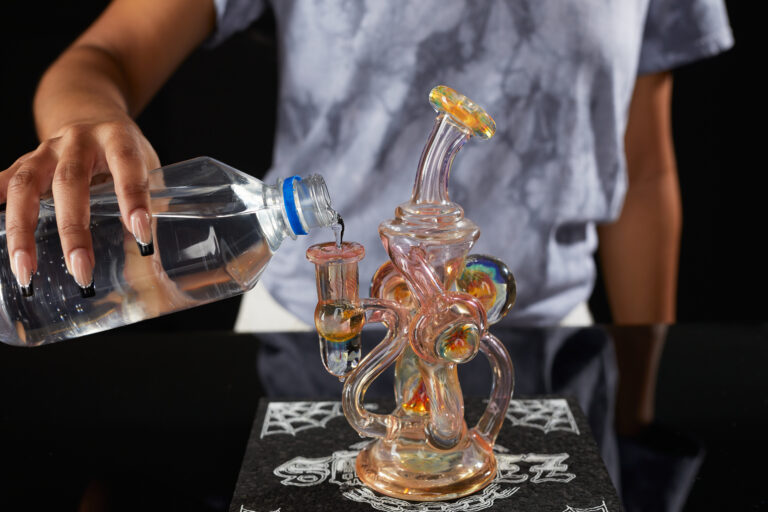 Photo by: Gina Coleman/Weedmaps
Photo by: Gina Coleman/WeedmapsImage lightbox

Add enough cold, clean water to cover three-quarters of the downstem.
Step 2: Heat nail or banger with torch
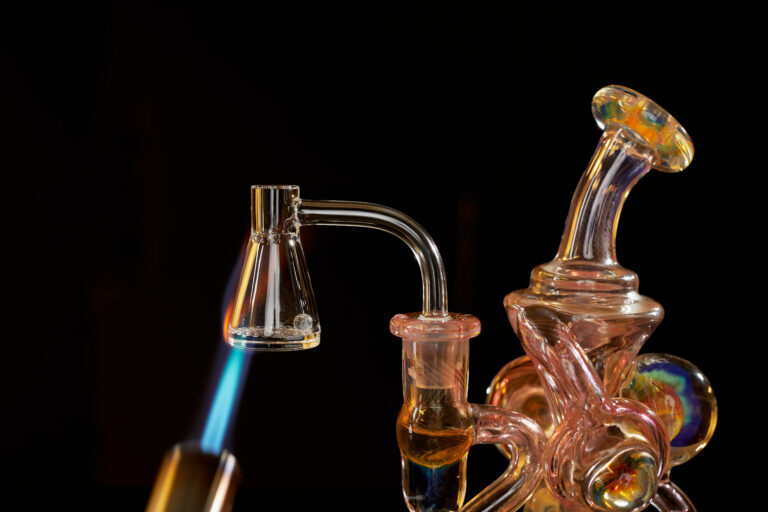 Photo by: Gina Coleman/Weedmaps
Photo by: Gina Coleman/WeedmapsImage lightbox

Heat your quartz evenly from the bottom and sides. It can take generally anywhere from 30 to 90 seconds depending on the shape and thickness of the nail or banger you're using.
Step 3: Wait for nail to cool
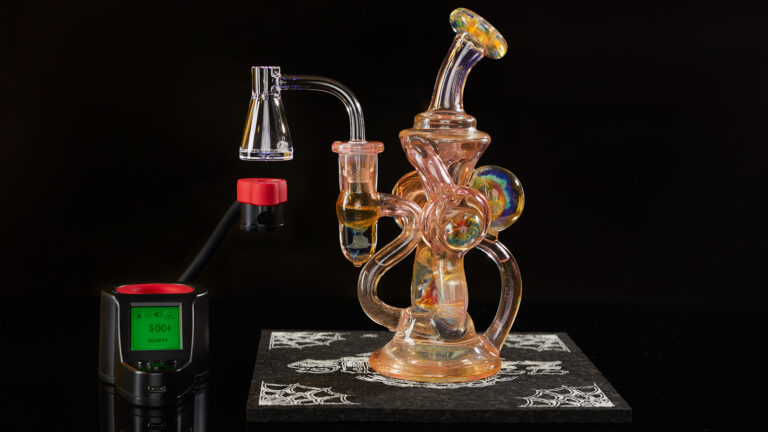 Photo by: Gina Coleman/Weedmaps
Photo by: Gina Coleman/WeedmapsImage lightbox

Wait between 30 - 60 seconds for the nail to cool—the temperature should range from 300 - 450°F (149 - 232°C).
Step 4: Add concentrate
 Photo by: Gina Coleman/Weedmaps
Photo by: Gina Coleman/WeedmapsImage lightbox

Using your dab tool, place a bit of your concentrate on the surface of the nail. Aim for an amount that's the size of a grain of rice or smaller if it's your first time dabbing.
Step 5: Place carb cap on the nail or banger
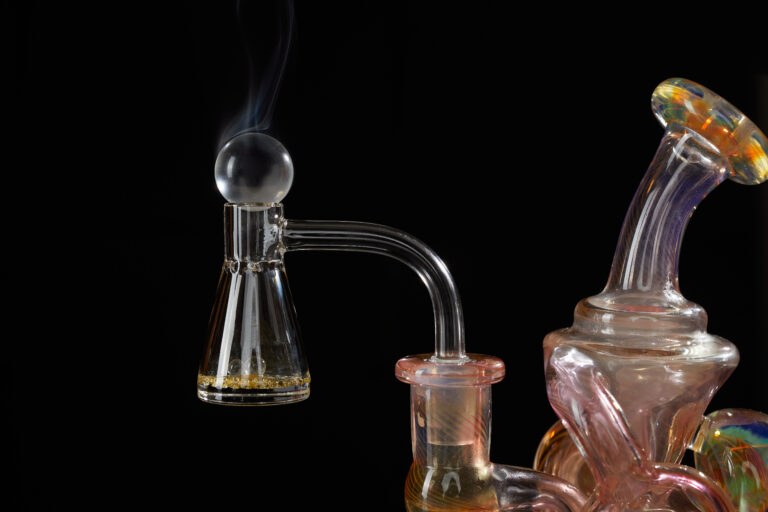 Photo by: Gina Coleman/Weedmaps
Photo by: Gina Coleman/WeedmapsImage lightbox

Before inhaling, set down your carb cap on the banger. This will help you to better vaporize your concentrate when you're ready to take a hit.
Step 6: Inhale
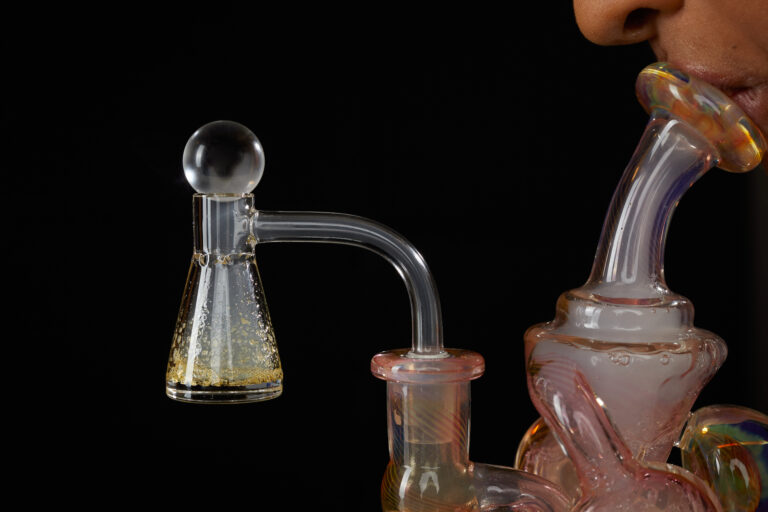 Photo by: Gina Coleman/Weedmaps
Photo by: Gina Coleman/WeedmapsImage lightbox

Unlike a typical bong hit of flower, dabs require a long, slow inhale as the majority of the concentrate does not vaporize instantly.
Step 7: Clean nail
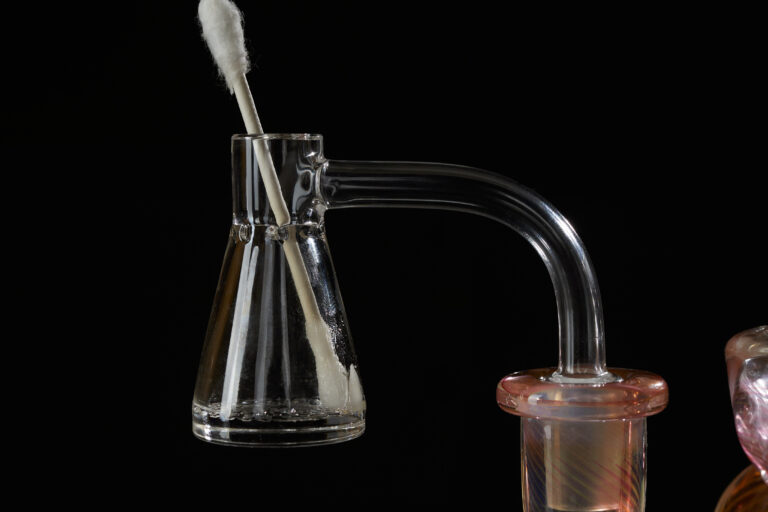 Photo by: Gina Coleman/Weedmaps
Photo by: Gina Coleman/WeedmapsImage lightbox

To prevent residue from possibly changing the flavor, always keep your nail clean. Allow the nail to cool down a bit and then swipe the inside of the warm nail with a cotton swab. For deep cleaning, dip a cotton swab in isopropyl (rubbing) alcohol and rub it along the interior of your warm nail.
Parts of a dab rig
The main components of a dab rig include:
- Water chamber: The part of the rig where water is held. The water cools and filters the vapor as it passes through, providing a smoother hit.
- Mouthpiece: The part of the rig where you inhale the vapor. Some rigs feature a bent neck or other designs to prevent water from reaching your mouth.
- Joint: The connecting point where you attach the nail or banger to the rig body. Joints come in various sizes and angles — typically 10mm, 14mm, or 18mm — and are either male or female. For example, if you have a water pipe with a 10mm female joint, you'll need to choose a nail with a 10mm male joint that fits into the water pipe's female joint.
- Nail or banger: The bucket-shaped part of the dab rig that holds the concentrate and is heated to vaporize it. It can be made from various materials, including quartz, ceramic, titanium, or glass. While many people use banger and nail interchangeably, they are actually a bit different. While both provide a place to put your concentrate so it can vaporize, a banger has more of a bucket shape, which makes it great for sauce or concentrates on the wetter end of the scale. A nail's head is flatter, which makes it more ideal for firmer concentrates like shatter and crumble.
- Banger bead: Also known as dab pearls or terp balls, they are convenient for those who enjoy low-temperature dabs. They assist in the movement of melted concentrate to hotter areas of the banger by spinning around a banger as you take a draw, allowing you to maximize your flavor experience.
- Dabber: Also known as a dab tool, this tool is used to apply the concentrate onto the heated nail or banger. Dabbers can be made from a variety of materials, such as glass, stainless steel, or titanium.
- Carb cap: A small accessory placed over the nail or banger after the concentrate has been applied. It helps regulate airflow and maintains heat, allowing for more efficient vaporization and fuller hits. Carb caps are usually made from titanium, quartz, or glass.
- Torch: More of an accessory than a part of the dab rig, you need a butane hand torch for heating the nail. Propane torches burn a hotter flame that can damage the nail.
- E-nail: Instead of heating your nail or banger manually with a blow torch and waiting for it to settle to the correct temperature, you can use an e-nail. This device lets you dial in a precise temperature and then electronically heats the nail to the exact temperature you chose.
Note: An important accessory to use with your dab rig is a dab mat. The primary purpose of one is to protect a surface, like a table, from dripping concentrate residue. Additionally, some dab mats are fully padded, which protects them from breaking or getting scratched. They're great for storing your rig when it's not in use.
FAQ
What's the best dab rig?
The perfect dab rig for you will depend on your personal preferences, budget, and dabbing experience. Explore Weedmaps' guide to the best dab rigs.
What are e-rigs?
E-rigs, or electronic dab rigs, are devices designed for vaporizing cannabis concentrates without the need for a traditional torch and nail setup. E-rigs typically consist of a base or battery, an atomizer (which acts as the heating element), and a glass or silicone apparatus similar to a water pipe. The base houses the battery and temperature controls, while the atomizer heats the concentrate to create vapor for inhalation.
What do you do if you have a bad trip after a dab?
You may have heard the term “greening out”. This occurs when a consumer takes in too much cannabis, which can lead to anxiety, dizziness, shortened breath, heightened sense of paranoia, among other side effects. It can also happen with dabbing.
If you take a dab and experience any of these symptoms, remember that no one has ever died from consuming too much weed. You will have to wait it out, but time is on your side. Take a few deep breaths, find a calm and safe spot to sit or lie down, turn on your favorite comedic show, and wait. To avoid greening out from dabs in the future, consider consuming your dabs at lower temperatures.
What's the best nail for dabbing?
Determining the best nail or banger for dabbing is mostly about matching your gear to your rig and personal preferences. Here are some general guidelines to help you figure out which type of nail is best for your consumption needs:
- Quartz: The best type of nail for the highest quality experience. Quartz retains temperature the best and is more durable than glass.
- Titanium nails: These tend to heat quickly and retain heat very well. They are also durable. However, with prolonged usage, it is possible to observe an accumulation of titanium oxide, which has the potential to hinder the efficiency of the dab nail and release toxic substances when exposed to elevated temperatures. If you decide to go the titanium route, it's recommended that you purchase a nail that is rated medical-grade.
- Ceramic nails: These require the most time to reach the desired temperature, but once they do, they excel at retaining heat. Additionally, ceramic nails tend to be very clean and do not pose the risk of leaching harmful substances into your dabs. But because they're ceramic, these nails are generally more vulnerable to breakage.
- Glass nails: Typically made of borosilicate glass, these nails are usually the cheapest to buy. However, glass nails are the most prone to breaking and can sometimes shatter at very high temperatures.
Can you turn your bong into a dab rig?
While not the ideal scenario since dabbing from a bong can gunk up your equipment, it's technically possible to transform a regular bong into a workable dab rig.
Be aware that most bongs or water pipes use a downstem situated at a 45-degree angle, which is very different from a dab rig's usual 90-degree angle. As a result, your nail will also be sitting at an angle, so make sure that your melted concentrates don't spill out of the nail while you're taking the dab.
- Locate a nail that is compatible with the downstem of your bong.
- Once your nail is fitted into the downstem, heat the nail as usual.
- Take a small amount of concentrate, place a carb cap over it, and breathe in through the mouthpiece
Are dab rigs legal?
Yes, dab rigs are legal. There is nothing criminal about owning the equipment in and of itself. However, the dabs themselves may or may not be legal depending on where you live. If you live in a weed-legal place where cannabis concentrates are allowed, then it's fine to possess dabs. But if you live in a place where marijuana is not legal, or where cannabis concentrates are not allowed, then it is illegal to own dabs.
Check the specifics of your local laws and regulations.
Can you dab CBD?
Yes, consuming CBD concentrates is the same as consuming THC concentrates. You'll need your dab rig and all the same accessories. From there, you'll dab your CBD concentrates in the same way, bringing the nail to the right temperature, dropping the dab onto the hot nail, inhaling the vapor, and cleaning the nail after you use it.
The optimal temperature for dabbing CBD lies between 320 – 356°F.
What does seasoning a nail mean?
Seasoning is a critical, one-time process that titanium and ceramic nails require. Learn how to season a nail.
Written by Tony Daniels | Featured image by Gina Coleman/Weedmaps

